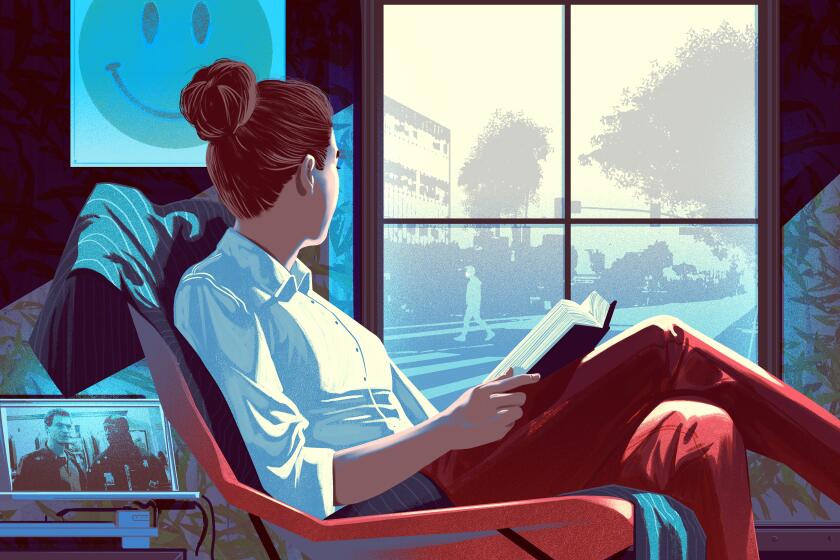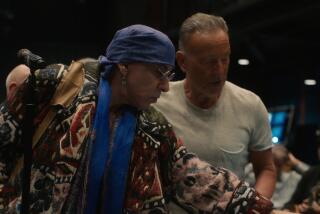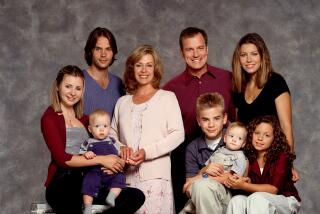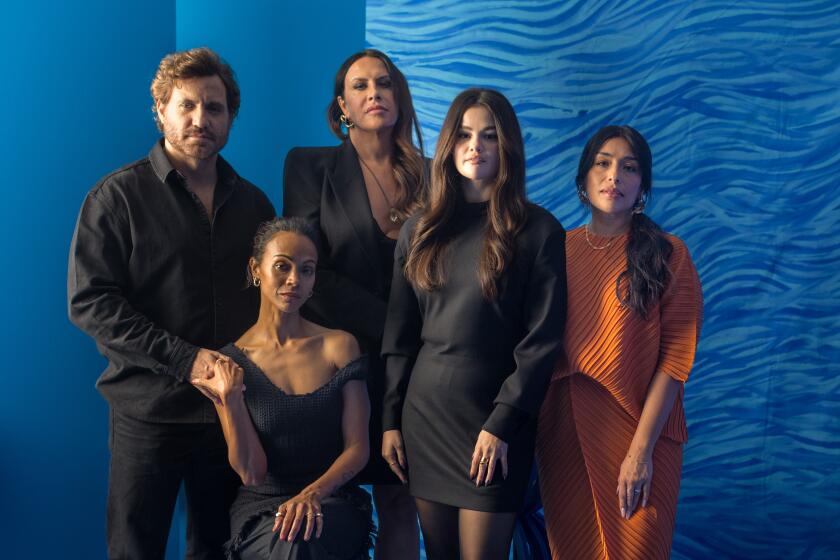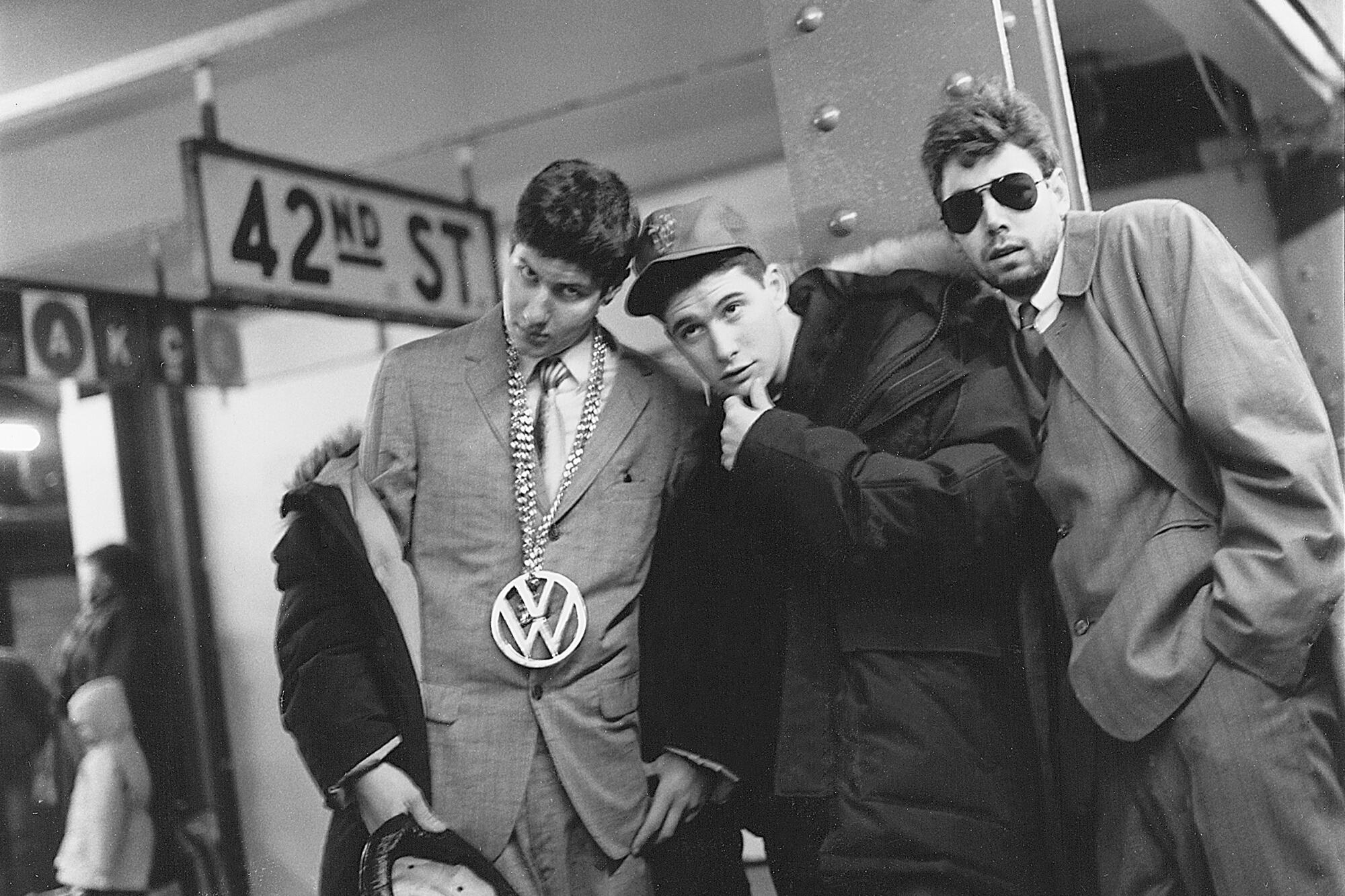
“This is nice, just hanging out with you guys.”
Spike Jonze is in Hawaii. Adam Horovitz is in his garage, and Michael Diamond is in his bedroom, both in Greater Los Angeles. It’s late March, not long after the coronavirus prompted shelter-at-home orders, and the three of them are on a video conference call ostensibly for an interview about their collaboration on the new film “Beastie Boys Story.”
Originally scheduled to have its world premiere at the South by Southwest Film Festival — canceled because of the global pandemic — the movie hits Apple TV + on April 24.
Though they are promoting the film — directed by Jonze as an adaptation of a stage show performed by Horovitz and Diamond, better known by their respective Beastie Boys monikers Ad-Rock and Mike D — the trio would rather just catch up, share in-jokes, playfully razz one another and think about anything besides the thing everyone can’t stop thinking about.
“This … is crazy,” Horovitz says at one point. “I got no plans to do nothing except try not to die. Straight up.”
There is the running gag that Diamond cannot get the camera on his computer to work — “Hold on, I’m going to crack the firewall,” Jonze says — or their complex relationship to “leather bad boys,” the type of couches ubiquitous to recording studios, or a digression about learning three-dimensional breathing techniques. More than anything they seem to want to make one another laugh, each disappointed when a joke doesn’t land.
“You’re a tough crowd,” Diamond says to his longtime cohorts.
“Beastie Boys Story” rose out of 2018’s “Beastie Boys Book,” a 571-page telling of the history of the band from their days as teenagers on the New York City punk scene in the early 1980s to their rise as a multi-platinum, Grammy-winning rap group. They had startling longevity and a knack for creative renewal, seeing them through albums such as “License to Ill,” “Paul’s Boutique,” “Check Your Head” and “Ill Communication” all the way to their last, 2011’s “Hot Sauce Committee Part Two.” Member Adam Yauch, known as MCA, died from cancer in 2012 at age 47.
Diamond and Horovitz didn’t really see themselves doing conventional book signings or Q&As to promote the book. The audiobook featured dozens of guest readers, including Chuck D, Elvis Costello, Rosie Perez, Bette Midler, Wanda Sykes, Ben Stiller, Amy Poehler, Jon Stewart, Kelly Reichardt, LL Cool J and Rachel Maddow. They decided to put on a stage adaptation of the book, a multimedia presentation directed by Jonze. They performed in several cities and filmed three nights in April 2019 at Brooklyn’s Kings Theater for the movie.
“We’re like, ‘Oh, let’s do a show,’” Horovitz says. “And so Mike and I wrote the show around the stories in the book. And then we asked Spike because, I don’t know if you know this, but Spike makes movies. And I haven’t seen any of them, but allegedly they’re good. And so we asked his advice and so then, as usual, Spike just sort of took over. And so Mike and I had this thing that we were going to do and then because Spike got involved it sort of evolved into something different, which is good.”
“I think it’s definitely our intent to have each thing sort of be its own thing,” Diamond says of the evolution from book to audiobook to stage show to movie. “But then I also really liked that it was kind of this continuous arc. Like I remember how we finished the book and I was going for a beach walk with Spike one day. And that’s before we even did our very first show, and I was like, ‘Adam and I are trying to figure out what to do. Pretend like we’re actual authors, wear Harris tweed blazers with suede patches and act professorial at bookstores?’
“And we talked about, well what if we picked the stories we like and made it a little more theatrical?” Diamond continues. “And it was kind of like that, this nice thing where we literally had no idea what we’re doing, but it seemed to kind of work and it felt good to us. And then originally I think we all thought that the film was going to be more of this document of what we’d done on stage, but then actually we realized once we started that it kind of took a life of its own and realized, no, it had to be its own thing.”
For a band that seemed dedicated to always moving forward to its next creative endeavor, its evolving cultural curiosities often making a road map to the styles of the zeitgeist, the idea of looking back might seem anathema.
“Oh, my God. Can we just do something different already? This … band. Right?” Horovitz says with a laugh of their recent retrospective phase. “Look, Adam Yauch’s not here. So any time we can think about him and write about him or tell stories about him or whatever, it’s sad but it makes me feel good to have him with me. And sometimes Michael Diamond also.”
Asked whether his perspective on the band has changed at all over the course of putting together the book and show and now movie, Diamond says dryly, “Bunch of jerks.”
He adds, “I think the thing that doing the show and movie and everything made me appreciate is just how completely frigging unlikely the whole thing is. Because while you’re in it and you’re making stuff, you don’t know. The fact that all these things happened in the first place and keep happening, in a good way — that we were really fortunate to be able to continue for this ridiculously long time and doing what we love with people that we love and still somehow managed to enjoy doing it. So I guess we appreciated that more.”
Throughout the book and on into the stage show and movie, Horovitz and Diamond are remarkably candid and reflective about mistakes they made along the way, such as the undiplomatic way they dropped their first drummer, Kate Schellenbach, from the band, or the bratty, regressive attitudes they displayed during the early “License to Ill” era and how they made a conscious effort to adopt more progressive views as they developed over the years. They are also very open about their relationship and eventual falling out with their first manager, Russell Simmons, and producer Rick Rubin.
“The interesting thing is that if you write a book about yourself, it’s a good opportunity to be able to rewrite history, right?” Horovitz says. “You can write whatever you want; you can write how amazing you were and you can blame other people for this, that and the other, whatever. And so I feel like we tried to just sort of tell it like it was.
“Good example, Russell Simmons,” Horovitz continues. “We had great times with Russell Simmons. He was really important to our band. Same with Rick Rubin, right? I’m not friends with either of them, but it was an amazing time that we had together. So that will remain. What does it do to yourself to pretend or to just block that out of your life?”
“I think that’s part of being fortunate,” Diamond says. “We actually got to be around long enough to comment on the dumb [stuff] that we did. I feel like a lot of times people just don’t get that moment of actually still having a voice or still having some relevance to be like, ‘Hold on, let’s rewind here for a minute and let’s look at what we did and sort of be able to live through that again.’”
Before Jonze can answer about his part in the process of making the stage show and the film, Horovitz interrupts — “Can we go back to the walk that you and Mike had on the beach?”
Jonze is now an Oscar-winning filmmaker. In the early 1990s he was transitioning from making skateboard videos to being one of the era’s most influential music video directors. He directed the video for the Beastie Boys’ “Sabotage,” an uproarious parody of ‘70s cop shows shot around Los Angeles that became a defining artifact of the mid-’90s. He drove a car in a demolition derby at a California county fair for the Beastie Boys’ short-lived magazine Grand Royal. Their mutual sensibilities of mischievous creativity seemed perfectly aligned.
“Well, I loved everything they did before I met them, so I kind of already had a relationship with them, in my head,” Jonze says. “And I think in meeting them, they were even cooler than in my imagination. They were more fun than I could have possibly hoped. And it felt very easy to make stuff with them. And I was maybe only a couple of years of younger, but certainly wasn’t successful or known in any way, but they treated me like an equal creative collaborator. It kind of fell right into place pretty easily.”
In directing “Beastie Boys Story,” Jonze wanted to convey his favorite things about the band, its members and their bond.
“What was cool about this and knowing them for over 25 years, almost 30 years, I got to I love the band musically and I love them as people,” Jonze says. “Just the way they work, the way they operate and why they do what they do and why they don’t do what they do. They’re very to themselves and what is right and wrong for them. And I loved getting to make this movie about the things I love about the band, about their friendship and how incredible that relationship is that the three of them had and getting to see it up close. They just really let themselves make whatever they wanted to make, whatever excited them or made them laugh.”
Many reviews of “Beastie Boys Book” note a passage in which Horovitz says that the death of Yauch was “too … sad to write about.” Yet in the “Beastie Boys Story” stage show and film, while recounting what would turn out to be the band’s last gig, Horovitz becomes visibly moved, the tone shifting to an vividly earnest and tender moment.
“I mean, think about if you had to read something about one of your best friends, not even in front of anybody, out loud. It’s just way different when you say something out loud,” Horovitz says of the moment. “And it happened every night.”
“It was really surprising to me,” Diamond says of what became the show’s emotional high point. “I think it surprised Adam, it surprised all of us. This is a thing that happened and we didn’t certainly didn’t plan on, certainly didn’t expect. Also, honestly, as a band, there’s plenty of moments where it felt like the three of us would keep doing this all together forever, and so here this person who was such an integral part of what we did and who was like our best friend, who led us in a lot of ways, through so many things, that here we are doing something without him. That was a new era for us.”
Having completed the book, the audiobook, the stage show and now the movie, this could conceivably be the end of the line for the collaboration between Horovitz and Diamond, wrapping up the business of being Beastie Boys.
So will they work together again on something new?
“I mean, I don’t want to,” Horovitz says, his joke landing with a bit of a thud as Diamond’s video-conference camera remained dark. “I wish I could see your face, Mike.
“I’m sure we’re going to. I mean what else are we going to do?” Horovitz continues. “We don’t know how to do anything else.”
“We don’t have any other life skills,” Diamond says, “although now we have some downtime to work on that.”
Here’s how to keep up with pop culture during self-quarantine due to coronavirus concerns.
More to Read
Only good movies
Get the Indie Focus newsletter, Mark Olsen's weekly guide to the world of cinema.
You may occasionally receive promotional content from the Los Angeles Times.
